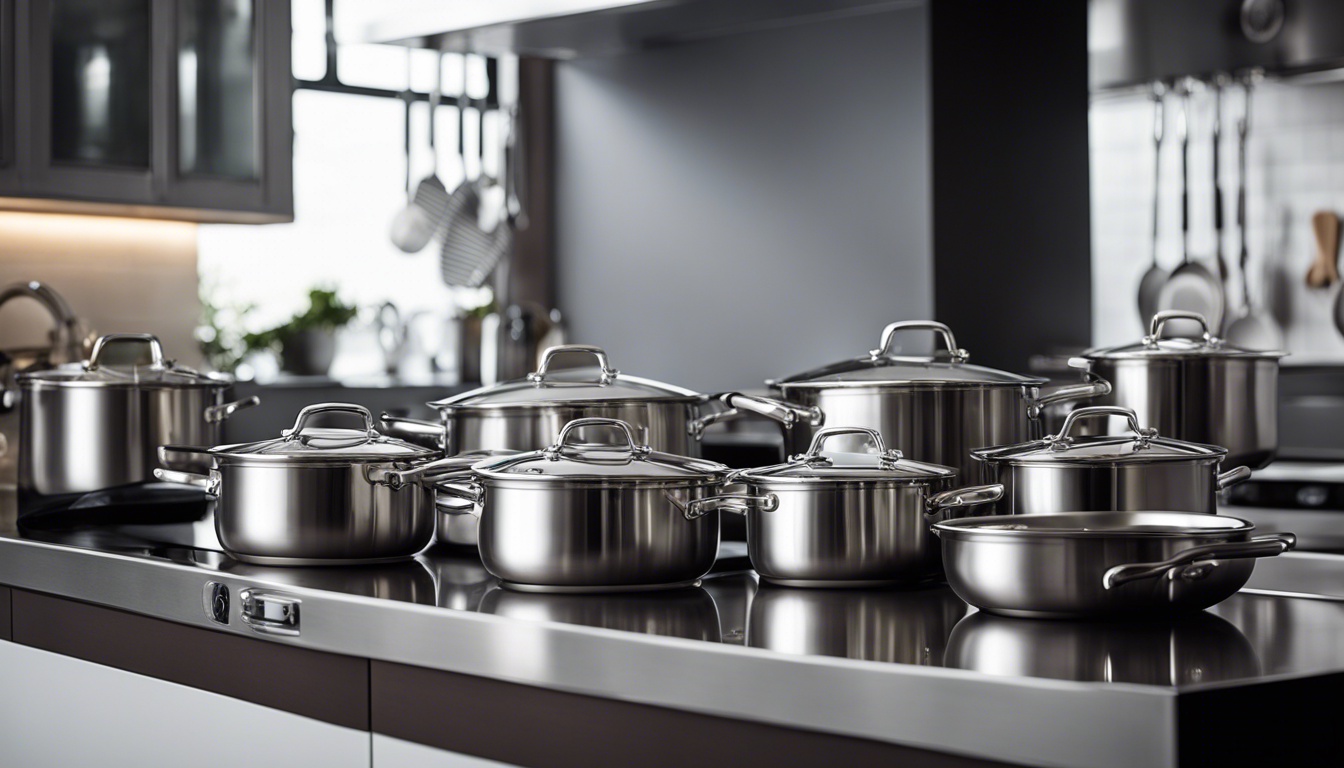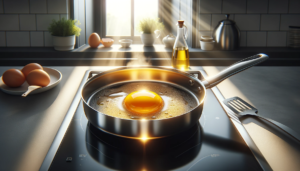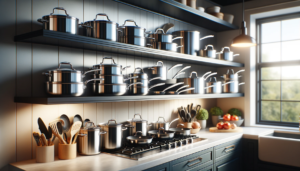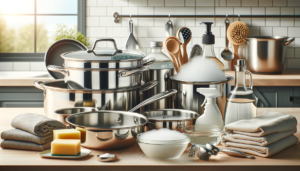With its durability and oven-to-table versatility, stainless steel cookware like Crofton’s line makes an attractive choice for busy home cooks.
But is using stainless steel pots and pans daily actually safe, or can compounds leach into food raising health concerns?
Let’s examine the realities around stainless steel cookware safety and usage to help you determine if Crofton and other leading brands earn a regular spot in your kitchen.
What is Crofton Stainless Steel Cookware?

Crofton is a brand of kitchenware products sold exclusively at Aldi grocery stores.
Their stainless steel cookware line features saucepans, frying pans, stock pots and more made from stainless steel.
The specific type of stainless steel Crofton uses varies across their product line.
Some popular options consist of an aluminum core sandwiched between stainless steel layers to improve conductivity and prevent hot spots, while their lower-cost items may use a single layer of 18/0 or 18/8 stainless steel.
All Crofton stainless steel cookware shares certain common features that make it practical for everyday cooking.
It is oven safe up to 500°F, allowing you to start stovetop dishes on the pans then transfer them straight to the oven to finish cooking.
The cookware is also dishwasher safe for easy cleanup, although hand washing is recommended to preserve the finish.
Well-made stainless steel cookware like Crofton’s is durable enough to resist scratches, chips and rust with proper care.
It also distributes heat evenly across the cooking surface.
Benefits of Stainless Steel Cookware

Stainless steel has long been a popular cookware material thanks to its unique benefits:
Durability
Quality stainless steel does not chip, scratch or rust easily like some other cookware materials when used properly.
This makes it ideal for years of regular kitchen use.
Stainless steel’s resilience comes from the chromium mixed into the alloy, which forms an invisible passive layer of chromium oxide over time when exposed to oxygen.
This protective layer shields against corrosion and tarnishing.
While it can scratch from metal utensils or scouring, fresh chromium oxide reforms quickly to maintain the integrity of the cookware.
Even Heat Distribution
Stainless steel itself conducts heat poorly compared to metals like aluminum and copper.
However, most stainless steel cookware combats this with a highly conductive layer integrated into the pan bottom, typically made of either aluminum or copper.
This enables efficient, even distribution of heat across the entire cooking surface with no frustrating hot spots.
Some Crofton stainless steel cookware incorporates an encapsulated aluminum disc layered in the pan base to produce this rapid, uniform heating.
Easy Cleaning
While not as effortlessly nonstick as ceramic or PTFE-coated pans, stainless steel’s naturally smooth, glossy surface allows food to release reasonably well when preheated properly with fats or oil.
This allows most regular cooking messes to wipe away easily with gentle dish soap and a soft sponge or cloth.
You can use stainless steel wool or non-chlorine scouring powders to tackle any stubborn cooked-on residue without compromising the pan itself.
Of course, being dishwasher safe also simplifies cleanup for busy home cooks.
Non-Reactivity
When cooking acidic ingredients like tomatoes, vinegar, wine or citrus juice, stainless steel’s low reactivity prevents metallic taste transfer or discoloration.
Reactive surfaces like aluminum and cast iron can leach an unpleasant flavor and appearance into such foods.
While ordinary stainless steel allows slight iron leaching that shows up visually, quality grades like 18/8 and 18/10 minimize this issue suitably for most home kitchen needs.
Stylish Appearance
With its classic metallic aesthetic, stainless steel cookware integrates beautifully into any modern kitchen design.
It suits both contemporary and more traditional interiors equally well.
The mirrored surface makes a striking statement and allows serving dishes straight from the stovetop to table when entertaining.
Stainless steel maintains its sophisticated image despite heavy use or imperfect cleaning compared to coatings that degrade over time.
Safety Considerations
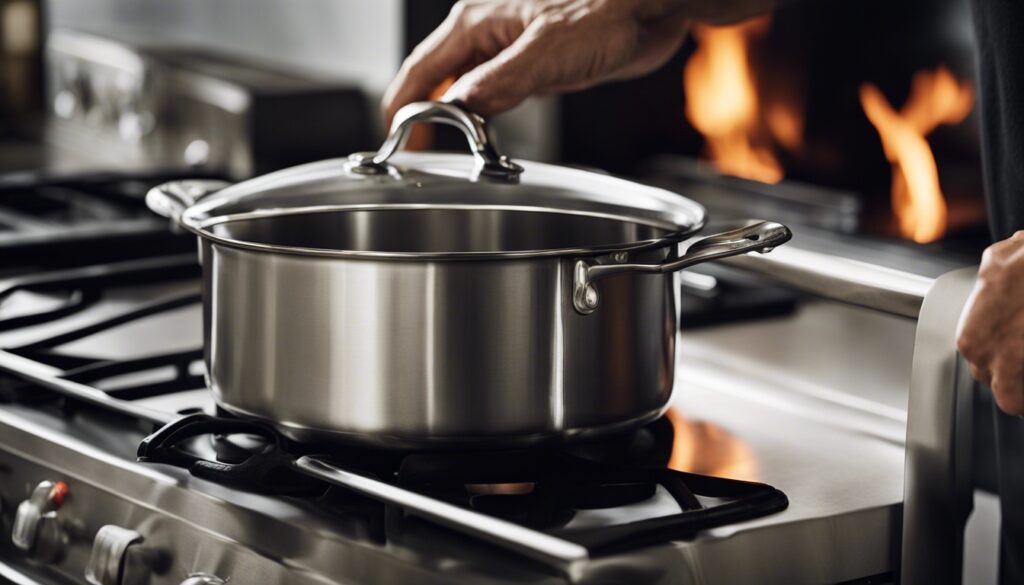
While stainless steel cookware offers numerous valuable advantages, a few safety considerations warrant attention for daily cooking use.
Potential Leaching of Nickel and Chromium
All stainless steel contains some nickel and chromium.
During cooking, small amounts of these metals can migrate from the cookware into acidic foods.
Extended high-heat cooking and damaging the pan’s passive layer increase the leaching potential.
The quantities released generally fall well below safety limits for food contact and irregular exposure poses little demonstrated health risks.
However, those with nickel allergies or sensitivities may wish to minimize acidic cooking in stainless steel.
Proper use and care provide adequate safety for most households.
Here are some tips for preventing excessive leaching from stainless steel pans:
- Avoid overheating empty cookware
- Do not use harsh scouring pads/cleaners that abrade the surface
- Use non-abrasive soft-scrub cleaners and gentle dish soap
- Wash gently with a soft sponge, cloth or brush
- Rinse away any cleanser residue thoroughly after washing
Not Naturally Nonstick
While stainless steel offers reasonable nonstick capabilities when cared for appropriately, it cannot compare to finishes made specifically for effortless food release.
Eggs, delicate fish and sticky batter-based foods often adhere frustratingly if not properly preheated and lubricated first.
Frequent stubborn sticking can scar the pan’s smooth cooking surface over time as well.
Prevent this with generous heating and oils/fats before cooking adherence-prone ingredients.
If food does get severely stuck on, avoid aggressive scraping during cleanup to protect the pan.
Oils and fats help prevent sticking issues when cooking foods prone to adhesion in stainless steel pans.
Thorough preheating also proves vital – when possible, heat empty cookware briefly before adding any fat or food.
If something does stick obstinately, soak the pan to loosen residue before washing gently.
Gets Very Hot & Retains Heat Well
Stainless steel’s even heat distribution combined with low conductivity result in cookware that gets extremely hot yet retains residual heat quite well after removing it from the burner.
The gleaming finish provides no visual cues that the empty pan remains dangerously hot either.
Use caution when handling hot stainless steel cookware to avoid painful steam burns or inadvertent skin contact.
Young children should keep clear while adults cook and serve in stainless steel pots and pans as well.
Likewise take care to position handles safely out of reach and avoid spills or splashes while cooking.
Let pans cool sufficiently before direct handling during and after cooking session.
Use potholders, oven mitts, folded kitchen towels or gloves when maneuvering hot stainless steel cookware.
Never allow children near the range unsupervised while pans heat up or cool down.
Position handles inward safely and wipe spills promptly to reduce risks.
Testing and Certifications

With stainless steel’s rising popularity in recent decades, various international agencies have developed standards and testing procedures focused on the material’s safety for cookware and food contact usage.
Understanding these protocols offers useful perspective when evaluating products like Crofton stainless steel pans.
International Safety Standards
Organizations including NSF International, the European Food Safety Authority (EFSA), the FDA and others have extensively researched stainless steel cookware to set safety guidelines and limits on potential leaching of metals like nickel and chromium into food during cooking.
For example, NSF/ANSI 51 certification indicates cookware meets guidelines for food safety and sanitization set forth by NSF International in an American national standard for food equipment verified through independent laboratory testing.
What Tests Check For
Typical laboratory testing analyzes stainless steel cookware to determine how much nickel or chromium could potentially migrate out under regular prolonged heating, abrasion or cleaning.
Tests often simulate extended boiling of acidic liquids, exposure to acidic or salty foodstuffs and worst-case damage to the pan surface.
Analyzing the food after contact shows whether metal quantities exceed permitted standards from agencies like the EFSA or FDA.
Durability tests may also assess stainless steel cookware construction by impacting it or gauging the hardness and adhesion of component layers.
Tips for Safe Use
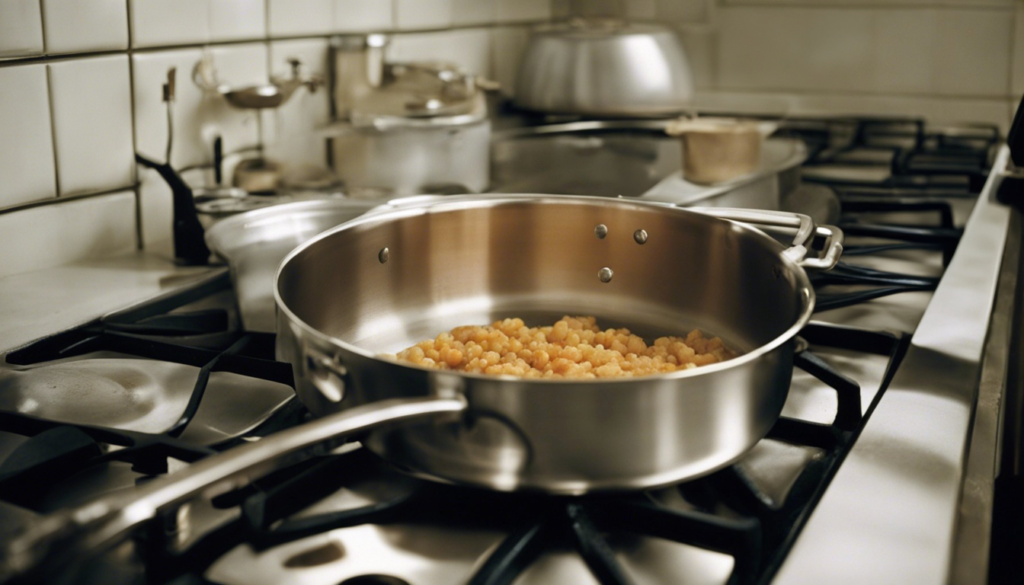
When used responsibly stainless steel pans pose little risks of health issues or injury.
Here are some key tips for secure Crofton stainless steel cookware usage on a daily basis:
Proper Preheating
Sufficiently preheating stainless steel before cooking provides the most significant strategy to prevent food adherence issues.
Empty pans require extra time to fully heat up and evenly expand the metal in preparation for ingredients.
2-3 minutes on medium stovetop heat works well for most pots or skillets.
Adding a tablespoon of oil and heating until shimmering also indicates readiness.
Always preheat stainless steel cookware thoroughly before cooking to minimize sticking troubles.
Place empty pans over medium stovetop heat and let them warm 2-3 minutes first.
Consider adding a small amount of oil, swirling to coat the surface, then heating until the oil shimmers to signal preparedness for any added ingredients.
This simple step makes a considerable positive difference.
Using Oils/Fats
A small amount of cooking fat or oil proves essential when sautéing meats, eggs or anything prone to adhering obstinately in stainless steel pans.
As mentioned, preheating alone helps significantly, but a thin layer of butter, oil or other lipids improves release even more.
Grease pans adequately when cooking notoriously sticky foods.
Low/Medium Heat
While stainless steel handles high stovetop temperatures admirably, delicate ingredients often demand lower gentle heating.
Eggs, fish fillets, pancakes and such fare best cooked over medium or medium low settings in stainless steel to avoid fast overcooking or burning.
Match heat level appropriately to what you cook.
Ensuring Flat Bottoms
The sides and bottoms of any quality stainless steel pan should lie perfectly flat and level naturally.
Avoid pieces that wobble or spin.
Cookware lacking flat, smooth bases cannot distribute heat evenly across the cooking surface leading to poor performance and hot spots a risk for food burning.
Confirm flatness by placing pans right side up on a very flat surface.
Spinning, movement or obvious gaps signal a defective uneven base.
Proper Handwashing
Always wash hands thoroughly with hot soapy water before and after handling any cookware and food products.
Clean hands limit the spread of germs and illness especially when cooking for others or those with compromised immunity.
Make vigorous 20-second hand scrubbing standard practice around meal prep.
Following Manufacturer Instructions
Review all enclosed use and care directions for new Crofton or other stainless steel cookware purchases closely.
Adhere strictly to any capacity, heating, seasoning or maintenance guidelines per the manufacturer.
This ensures ideal safety plus maximum product performance and longevity.
Reach out regarding any concerns not addressed in materials.
Conclusion
In summary, when utilized appropriately quality stainless steel cookware like Crofton poses very minimal health or injury risks for home kitchen purposes.
Concerns regarding leaching metals, sticking and burns mostly relate closely to consumer education around proper practices.
Generally Considered Safe
With an informed user stainless steel cookware serves as a durable, non-reactive, oven and dishwasher safe choice suitable for daily cooking needs.
International testing and standards confirm metals transfer rates within safe limits for food contact following common sense precautions.
Top brands meet regulations through third-party labs ensuring consumer protections as well.
Purchase & Use Tips
Seeking out high-grade 18/8 or 18/10 stainless steel offers assurance, as do verifications like NSF listing.
Initialize new pans correctly per enclosed manufacturer directions.
Always preheat adequately before cooking alongside fats/oils when suitable plus adjust heat levels down for delicate foods.
Employ non-abrasive cleaning and avoid metal utensils scraping pans to prevent damage.
Standards to Look For
Credible seals like NSF certification demonstrate compliance with food equipment safety guidelines, while designations like 18/10 highlight quality stainless steel grades.
Both indicate durable cookware lasting for years with proper care.
Review included use and care booklets thoroughly too when buying and remain mindful of general stainless steel best practices for ideal results.
